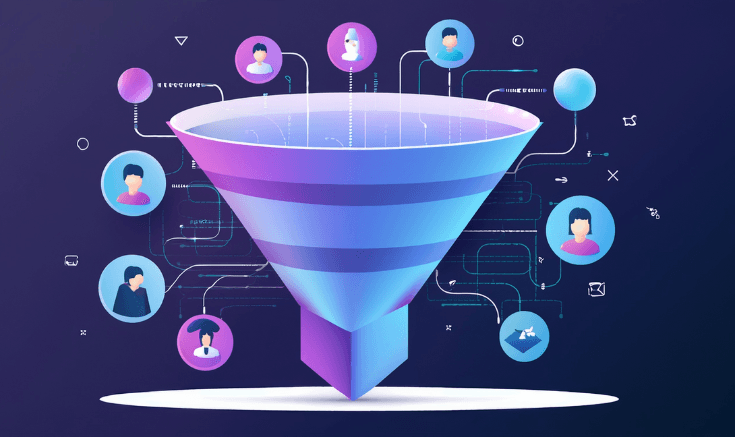

9 key benefits of AI personalization tools
APR. 29, 2025
7 Min Read
AI personalization elevates the way businesses deliver products and services to their intended audiences.
Machine learning optimizes user interactions by highlighting the right offer or message at the most suitable moment. Each touchpoint becomes more relevant, turning awareness into sustained interest and frequent purchases. Decision-makers also gain confidence that marketing resources are allocated with maximum impact, uniting data insights and customer needs for sharper outcomes. Traditional strategies often struggle to keep up with changing preferences and larger data sets. Personalization tools for AI analysis provide an efficient path to gather insights and adjust messaging on the fly, giving each user a tailored experience. Complex tasks such as segmenting audiences or identifying emerging trends take far less time when powered by artificial intelligence. The result is growth that feels continuous and aligned with what customers truly want.
key-takeaways
- 1. AI personalization raises conversions by aligning promotional messages with specific buyer needs.
- 2. Targeted approaches reduce inefficient marketing spend, focusing only on profitable segments.
- 3. Data analysis becomes simpler and quicker, supporting timely strategic decisions.
- 4. Personalization scales easily, making it practical for growth plans and expansion into new markets.
- 5. Tailored experiences cultivate strong user loyalty, driving repeat business and referrals.
9 key benefits of AI personalization tools

Enhanced customer experience
Delivering a personalized user journey starts with analyzing buying patterns, page visits, and feedback loops so each visitor receives content aligned with specific preferences. AI personalization tools apply machine learning models to discover insights that guide individualized product recommendations, targeted email campaigns, and intuitive website navigation. This approach establishes a tailored interaction that resonates with varied audiences, helping business decision-makers demonstrate that they understand each segment’s exact needs. A purposeful method like this establishes trust, streamlines each engagement, and positions brands as genuinely responsive.
Evidence of improved user satisfaction emerges through reduced bounce rates, higher average order values, and ongoing customer advocacy. A targeted approach helps B2B and B2C providers focus efforts where it matters, making use of real-time data to refine every step of the customer lifecycle. Many organizations gain significant cost benefits by concentrating marketing resources on strategies that reveal the highest potential for conversions. Observed outcomes often include better online reviews, increased referrals, and a steady rise in revenue from loyal audiences.
Increased customer engagement
Connecting with customers in meaningful ways relies on the ability to interpret preferences. AI personalization tools provide a robust strategy to adapt and deliver messages for each individual, boosting click-through rates and interactions. By focusing on precise segments and refining the timing of promotions, organizations see greater open rates, stronger brand loyalty, and a notable lift in overall interaction. This method not only shortens the path from awareness to purchase but also sets up a lasting relationship based on continuous relevance.
Stronger engagement translates into multiple channels, whether it is website-based messaging, email campaigns, or social media conversations. When the right message lands at the right time, customers feel recognized, making them more likely to share their positive experiences. Companies often see faster movement in the sales pipeline, with fewer wasted opportunities from customers who leave due to irrelevant content. Metrics like dwell time and click rates frequently improve, demonstrating a direct link between personalization and impactful engagement.
Improved conversion rates

Personalized approaches reduce friction and streamline the journey from introduction to purchase or commitment. AI personalization tools apply data-led insights to identify the preferred content format, product arrangement, and checkout sequence for each visitor. This helps address pain points such as poor website navigation or irrelevant offers, creating a user journey that feels intuitive. Conversion rates grow when users encounter curated suggestions and promotional messages that resonate with their goals.
Targeted tactics can contribute to consistent revenue growth by aligning each step of the funnel with data-backed insights. Marketing teams gain the ability to test multiple experiences in real time, optimizing conversions without guesswork. In turn, decision-makers see how daily sales figures climb when consumers receive promotions or recommendations tied to their specific histories. An evidence-based approach like this reduces acquisition costs, strengthens lead quality, and highlights ways to refine promotional activities for greater returns.
Efficient data analysis
Gathering data is only half the battle when optimizing business outcomes. Accurate interpretation requires systems that sift through large data sets quickly and highlight opportunities for deeper personalization. AI personalization tools excel in summarizing these volumes of information, providing dashboards and automation that help marketing teams direct initiatives efficiently. This level of organization saves time, supports cost-effective decision structures, and reduces the risk of human error in managing multiple inputs.
Real-time analytics help decision-makers discover emerging market trends and evolving consumer tastes. This can lead to identifying new product lines or promotional themes that resonate with previously overlooked segments. Faster data analysis also supports ongoing adjustments, whether that means testing a new set of personalized banners or refining targeted email sequences. Leaders gain immediate visibility into what drives results, promoting a culture where learning from data is standard practice.
Scalability in marketing efforts
Companies planning to grow into new markets or verticals often need flexible methods to manage increasing demand for personalized experiences. AI personalization tools provide that flexibility without forcing marketing teams to develop multiple parallel strategies from scratch. Automated processes use machine learning to handle spikes in traffic, ensuring that each visitor still receives relevant messaging. This approach allows rapid expansion into diverse customer segments while preserving consistency in brand messaging.
A structured foundation helps teams manage personalization across different channels, saving resources and time. Content creators can rely on the same underlying data to produce marketing collateral, streamlining workflows around development and deployment. Rolling out new campaigns and promotions at scale becomes easier because the system adapts to a growing data set without sacrificing performance. This contributes to sustainable marketing practices that balance cost effectiveness with high growth potential.
"AI personalization tools provide that flexibility without forcing marketing teams to develop multiple parallel strategies from scratch.”
Real-time decision making
Businesses looking for a quick path to value frequently need swift adjustments during ongoing campaigns. AI personalization tools offer instant insights into user activity, revealing what works and what needs to be revised. Teams can switch marketing tactics on the spot, improving returns by emphasizing content that resonates and sidelining unproductive angles. The ability to adapt with minimal delays helps companies stay fresh and tuned in to emerging customer needs.
Adjustments in real time can lift click-through rates, reduce cart abandonment, and prioritize messaging that captures buyer intent. Sophisticated algorithms evaluate fresh data, anticipate potential shifts, and recommend strategic optimizations. A culture of responsiveness establishes confidence among stakeholders who rely on data-powered updates, particularly when aligning marketing with operational goals. Speed often becomes an edge, especially when companies move from initial concept to live campaign within days instead of weeks.
Competitive advantage in the market
Distinguishing a product or service often hinges on the ability to serve tailored experiences. Personalized interactions attract return visits from clients who recognize that their needs come first. This distinction can translate into a stronger position when negotiating partnerships, discovering new revenue streams, or building relationships with high-value customers. Many organizations find that personalization cements a deeper sense of loyalty, which in turn fuels better brand recognition.
Gaining an advantage in the market can help reduce churn, increase margins, and expand visibility among industry peers. Buyers tend to choose vendors who present curated solutions that feel relevant and timely. The result is a cycle of engagement where current customers keep buying while new ones arrive at a higher pace. These outcomes drive measurable business impact, positioning teams to secure resources and stakeholder support for the next wave of digital initiatives.
Personalized content delivery

Delivering content that resonates requires segmenting users based on attributes such as past purchases, consumption patterns, and preferences. AI personalization tools automatically segment and assign tags to each user, ensuring that the most relevant messages appear in emails, social posts, and product recommendations. The capacity to refine content distribution cuts through noise, reducing the likelihood that customers feel overwhelmed by irrelevant promotions. This maintains a clean, user-friendly experience where each interaction adds tangible value.
An intelligent content strategy means that every email or landing page stands a better chance of converting. This can significantly reduce costs associated with broad, untargeted campaigns that yield minimal results. Leaders who invest in personalized content often note stronger relationships with audiences, since customers recognize a meaningful attempt to address specific concerns. Evidence of success includes improved engagement metrics, more frequent repeat purchases, and positive feedback on social channels.
Enhanced customer loyalty
Maintaining loyalty depends on sustained engagement and shared value. AI personalization tools help businesses create a reliable cycle of interactions, from discovery to post-purchase support. Returning customers often see new recommendations that match evolving tastes, minimizing the chance they will seek alternatives. This long-term approach resonates with audiences that value continuous improvement, leading to lower churn and more predictable revenue streams.
Consistent loyalty over time can offset marketing expenses by building a base of devoted advocates who spread positive feedback organically. Many organizations track key performance indicators such as retention rates, lifetime value, and repeat purchase frequency to confirm success. These tools for AI personalization can reveal fresh upsell and cross-sell opportunities that cater to loyal segments. By combining personalization with proactive service, businesses establish the trust essential for ongoing engagement.
Implementing AI personalization tools effectively

Developing a plan for AI-based personalization starts with identifying specific objectives related to retention, profitability, or conversion boosts. A thorough audit of existing data systems ensures that information can be integrated without disruptions. It is vital to address any data privacy concerns at the outset by defining clear guidelines for ethical data usage. Testing small pilot programs can help validate strategies, reduce risk, and confirm that the solution aligns with the organization’s goals.
Building organizational readiness for personalization involves educating teams about how to use new insights in daily workflows. Marketers may need training to interpret analytics dashboards, while sales teams might shift toward more context-based pitches. Collaborative governance models clarify who owns different parts of the personalization process, leading to consistent accountability. With roles and responsibilities defined, it becomes easier to adapt strategies when market conditions shift or when new data sources become available.
Regular maintenance is key for sustained success. Machine learning models must be retrained periodically to capture changing consumer behaviors or product line shifts. IT departments often coordinate system updates, ensuring that integrations and performance remain stable as demand grows. Close coordination between technical experts and business stakeholders creates a feedback loop that refines personalization practices and supports continuous improvement.
“A thorough audit of existing data systems ensures that information can be integrated without disruptions.”
Measuring the ROI of AI personalization tools

Proving value requires metrics that resonate with leadership teams and investors. Return on investment often appears through incremental revenue gains, higher engagement rates, or elevated net promoter scores. Initial investments in infrastructure and data management can be recouped if businesses can connect personalization efforts to quantifiable outcomes. A systematic approach to measurement might involve before-and-after comparisons, control groups, or A/B testing to validate that personalization truly influences results.
Identifying revenue lift is not the only measure. Leaders may track the cost savings that come from focusing on segments with higher potential, rather than blanketing all channels. Several organizations also emphasize improved speed to market as a deciding factor, since personalization often accelerates user acquisition by removing common friction points. Over time, success stories become tangible evidence for potential partners, customers, or investors evaluating the effectiveness of personalization efforts.
Tracking these outcomes allows decision-makers to determine whether the tools in use are delivering the desired results. Refinements can be made as soon as performance data suggests a slowdown or mismatch between user expectations and delivered experiences. This attention to clear, measurable returns encourages further investment in AI personalization tools and confirms that data-led personalization remains an essential component of a scalable marketing approach.
AI personalization is more than a marketing trend—it strengthens the connection between businesses and their audiences. Tailored, data-powered recommendations spark better experiences, leading to measurable returns that impact revenue and loyalty. At Lumenalta, we specialize in developing solutions that align with your objectives, paving the way for meaningful growth. Let’s chart a brighter path.
table-of-contents
- 9 key benefits of AI personalization tools
- 1. Enhanced customer experience
- 2. Increased customer engagement
- 3. Improved conversion rates
- 4. Efficient data analysis
- 5. Scalability in marketing efforts
- 6. Real-time decision making
- 7. Competitive advantage in the market
- 8. Personalized content delivery
- 9. Enhanced customer loyalty
- Implementing AI personalization tools effectively
- Measuring the ROI of AI personalization tools
- Common questions about AI personalization tools
Common questions about AI personalization tools
What types of businesses gain the most from AI personalization tools?
How do AI personalization tools handle large amounts of customer data?
What is the difference between standard segmentation and AI-based personalization?
Do AI personalization tools increase operational costs?
Are there risks related to data privacy with AI personalization tools?
Want to learn how AI personalization can bring more transparency and trust to your operations?









